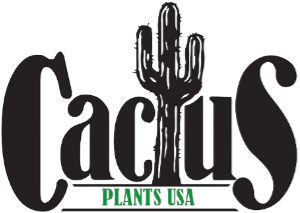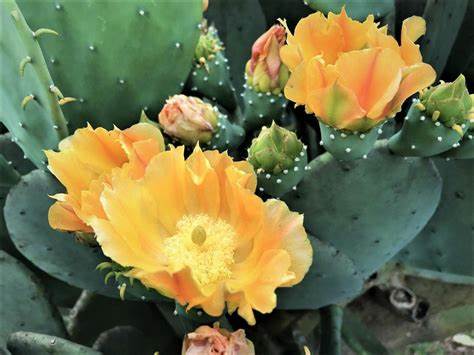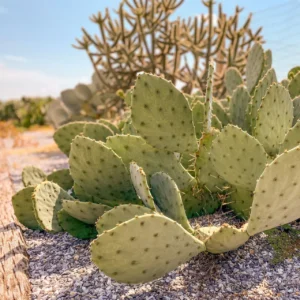Spineless Prickly Pear Cactus For Sale – Thornless, Edible & Drought-Tolerant
The Spineless Prickly Pear Cactus (Opuntia ellisiana) is a thornless, fast-growing, drought-tolerant cactus perfect for xeriscaping, sustainable gardening, and edible landscaping. This low-maintenance, spineless variety produces nutrient-rich edible pads (nopales) and sweet prickly pear fruits (tunas), making it a great addition to desert gardens, permaculture setups, and indoor potted plant collections.
Native to Mexico and the Southwestern United States, this heat-resistant succulent thrives in hot, dry conditions, yet adapts well to various soil types. Whether you’re looking for an easy-to-grow ornamental plant, a food source, or a natural privacy screen, this drought-resistant cactus is an ideal choice.
Available for Fast Shipping Across the USA & Canada!
Key Features
- Thornless & Safe for Handling – Perfect for pet-friendly & family-friendly gardens
- Edible Pads & Fruits – High in fiber, vitamins, and antioxidants
- Fast-Growing – Grows up to 12 inches per year
- Drought-Tolerant & Low-Maintenance – Thrives in dry and arid conditions
- Hardy in USDA Zones 7–11 – Withstands temperatures down to 15°F (-9°C)
- Pest & Disease Resistant – Naturally repels common plant pests
- Excellent for Erosion Control – Helps stabilize sandy or rocky soils
Other names: “Thornless Nopales Cactus,” “Edible Spineless Cactus,” “Opuntia Cactus for Sale.”
Scientific Benefits & Nutritional Value
Health Benefits of Spineless Prickly Pear Cactus
Scientific studies have shown that Opuntia species offer a range of nutritional and medicinal benefits, including:
- Regulating Blood Sugar Levels – Studies indicate that nopales help reduce post-meal glucose spikes, making them beneficial for diabetes management.
- High in Antioxidants – Contains betalains & flavonoids, which protect against oxidative stress and inflammation.
- Supports Gut Health – Rich in soluble fiber, aiding digestion and gut microbiome balance.
- Hydration & Electrolyte Balance – The high water content of pads supports hydration in hot climates.
- Liver Detoxification – Traditional medicine uses prickly pear extracts to promote liver health and toxin elimination.
Nutritional Profile (per 100g of Prickly Pear Fruit)
- Vitamin C: 14 mg (15% DV) – Supports immunity
- Magnesium: 85 mg (21% DV) – Essential for muscle & nerve function
- Potassium: 220 mg – Helps regulate blood pressure
- Fiber: 3g – Aids digestion and gut health
- Low-Calorie: Only 42 kcal per 100g
Scientific Source: National Center for Biotechnology Information (NCBI)
Benefits of Growing a Spineless Prickly Pear Cactus
1. Completely Thorn-Free for Safe Gardening
Unlike most cacti, Opuntia ellisiana is 100% thornless, making it ideal for homes with children and pets.
2. A Nutrient-Rich, Sustainable Food Source
- Pads (nopales) are used in Mexican dishes, stir-fries, and smoothies.
- Fruits (tunas) are great for jams, juices, and cocktails.
Quick & Easy Recipe Idea: Nopales Stir-Fry
- Slice fresh nopales into strips.
- Sauté with onions, garlic, and bell peppers.
- Season with salt, lime juice, and enjoy as a side dish or taco filling!
Want more edible plants? Browse our Organic Edible Garden Collection!
3. Eco-Friendly & Drought-Resistant
- Requires up to 80% less water than standard garden plants.
- Great for erosion control on slopes and sandy soil.
4. Attracts Pollinators & Wildlife
The bright yellow flowers attract bees, butterflies, and hummingbirds, increasing biodiversity.
5. Landscaping & Decorative Uses
- Perfect as a decorative potted plant.
- Can be used as a natural fence or privacy hedge.
How to Care for Your Spineless Prickly Pear Cactus
1. Sunlight Requirements
- Requires 6–8 hours of full sun daily.
- Indoor placement? Use a south-facing window or a grow light.
2. Best Soil & Drainage Conditions
- Prefers sandy, well-draining soil.
- Avoid dense soils to prevent root rot.
3. Watering Schedule
- Spring & Summer: Once every 2–3 weeks.
- Fall & Winter: Once a month.
- Tip: Overwatering is the most common mistake!
4. Temperature & Climate
- Hardy in USDA Zones 7–11.
- Protect from frost if temperatures drop below 15°F.
5. Fertilization & Growth
- Use a cactus fertilizer in early spring.
- Growth rate: Up to 12 inches per year.






Reviews
There are no reviews yet.